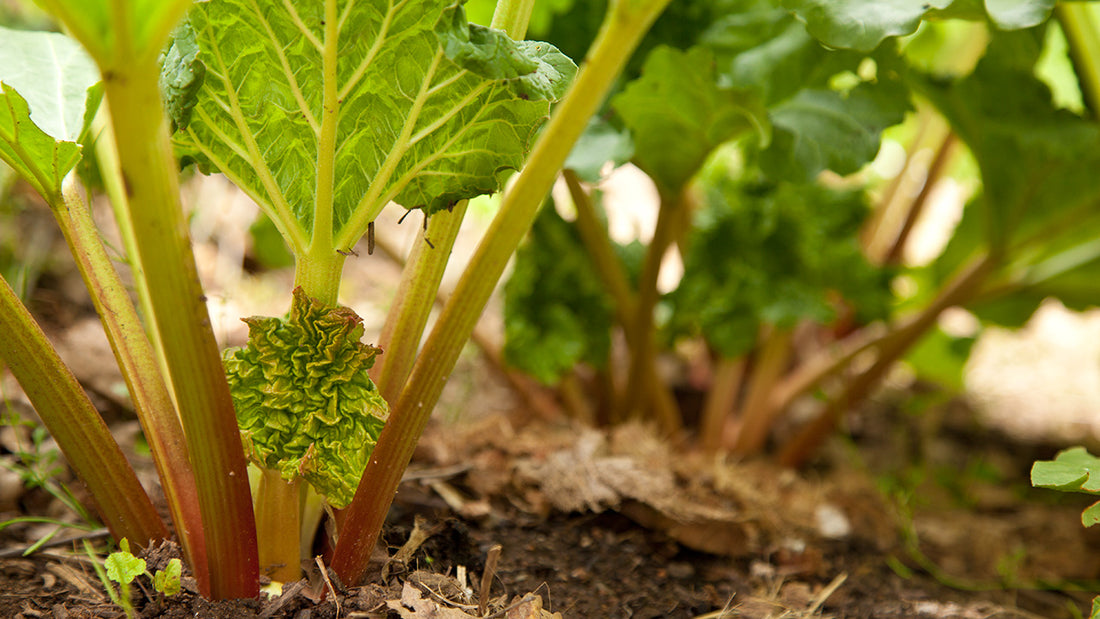Introduction
Rhubarb is a cool season, perennial plant that is very winter hardy and resistant to drought. Its crop is produced from crowns consisting of fleshy rhizomes and buds. Following a season of growth the rhubarb crown becomes dormant and temperatures below 40°F are required to stimulate bud break and subsequent growth. The first shoots to appear in the spring are edible petioles and non-edible leaves. These emerge sequentially as long as temperatures remain cool (below 90°F). As temperatures increase, top growth is suppressed, even appearing dormant in periods of extreme heat. With declining temperatures in later summer, foliage growth resumes.
Climate and Growing Region
Rhubarb is a cool season, perennial crop. It requires temperatures below 40°F to break dormancy and to stimulate spring growth and summer temperatures averaging less than 75°F for vigorous vegetative growth. The Northern U.S. and Canada are well suited for rhubarb production. In the United states it grows best in the northern states from Maine south to Illinois and west to Washington state. Once planted, rhubarb plantings remain productive for 8 to 15 years. Rhubarb cannot be successfully grown in the southern regions of the United States–the plant needs the cold winter temperatures to grow the following year. Rhubarb is a popular garden vegetable in northern areas of the United States but unfortunately will not do well in hot, dry summers of the south. If it survives the heat, it will not grow well and will produce only thin leaf stalks which are spindly and lack color. Rhubarb will wilt very quickly on hot days (over 90°F)
Soil
Rhubarb tolerates most soils but grows best on fertile, well drained soils that are high in organic matter. A clean planting site is essential for the cultivation of rhubarb. Small areas of perennial weeds can quickly build up to serious proportions. To prevent this, all perennial weeds should be killed the year before planting. The fields should be cultivated in the spring and after cutting, hand hoeing may also be necessary. Rhubarb is relatively free of insect and disease problems.
Fertilization
Rhubarb is rather tolerant of soil acidity but does best in slightly to moderately acid soil. The crop can tolerate soil pH as low as 5.0; however, maximum yields are attained at a pH of 6.0 to 6.8. Liberal quantities of fertilizer are needed. Rhubarb responds well to fertilizers. The quality of the crop harvested depends to a large extent on the care and fertilization received. Home gardeners can fertilize with
All Purpose Plant Food 5-5-5 fertilizer, or similarly balanced fertilizer each spring. Fertilize each year and cultivate shallowly as often as necessary to remove weeds. Compost is an extremely valuable source of organic matter as it helps to conserve moisture, preserves the soil structure, and makes nutrients readily available. Apply compost in late fall or early winter, but do not cover the crowns as this may promote rotting.
Planting and Spacing
Space rhubarb roots 24 to 48 inches apart in rows 3 to 4 feet apart for commercial growing. These distances can be decreased to 36 inches for plants in rows and rows for smaller home gardens. Much smaller than this will seriously crowd the plants and result in a diminished crop and increase the likelihood of spreading disease. Plant the roots with the crown bud 2 inches (5 cm) below the surface of the soil. The hole for the crown should be dug extra large and compost should be mixed with the soil to be placed around the roots. Firm the soil around the roots but keep it loose over the buds. Water the crowns after planting. Good garden drainage is essential in growing rhubarb. For home gardeners, planting in raised beds helps ensure against rotting of the crowns.
General
Rhubarb responds to good care and watering. Remove the flower stalks as they are seen. During the first year of planting, the stalks should not be picked, since food from the leaves is needed to nourish the roots for the next year's growth. One light picking may be taken during the year following planting if the plants are vigorous, and beginning the second year following planting, the entire plant may be harvested. When harvesting rhubarb, the first step is to cut the stalks at the soil line. All of the stalks of a plant may be harvested at one time, or pulled out selectively over a 4-6 week period. After the stalks are cut, the leaves may be removed. For the home (small) gardener, rhubarb will tolerate a fair amount of neglect and still thrive, they are very tough plants.


2 comments
Ronald, rhubarb plants can grow from 8-15 years. I would just remove the flower.
I have a rhubarb plant that I have had for many years and it’s growing like a big flower on the top not sure if it’s good or how long do the plants last ?